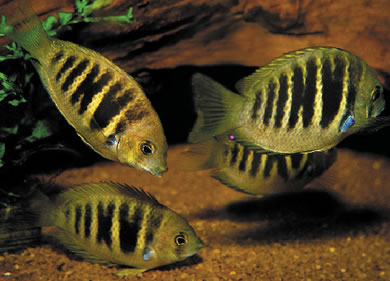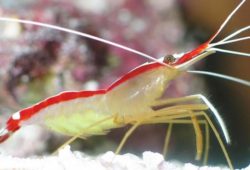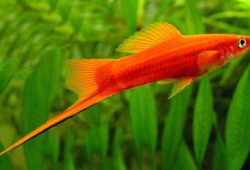The shoaling cichlid
The article gives you some information on The shoaling cichlid. Everyone knows that cichlids are found in South America, Central America and Africa, but there is also a group of cichlids that occur on the other side of the world the Asian genus Etroplus.

While the diversity of cichlids in Africa and the Americas is pretty vast, with probably over 1000 species in Lake Malawi alone, the Asian Etroplus haven’t radiated as much and there are only three species known. Two of these, the Orange chromide, E. maculatus, and the Green chromide, E. suratensis, are relatively easy to obtain in the shops here, but the third species, the Canara pearlspot, or Banded chromide, E. canarensis is a much rarer find.
Although it was described by Day way back in 1877, the species went unseen for so long that most believed the fish had gone the way of the Dodo. It wasn’t until 1992 that the fish was rediscovered by ichthyologist Rohan Pethyigoda a man who is already famous for rediscovering Puntius denisonii and the Dwarf puffer, Carinotetraodon travancoricus.
Having kept and spawned other Etroplus in the past, I was really keen to have a crack at trying my luck with canarensis. I was lucky enough to bag half a dozen youngsters for myself in the summer of 2004, courtesy of Technical Writer Jeremy Gay, who was then working in the trade and had managed to persuade his supplier in India to send him some.
Most unusual behaviour
Etroplus canarensis is the most graceful and unusual cichlid I have ever kept. Perhaps the most unusual thing about them is that the whole group was almost completely non-aggressive and shoaling. My six youngsters (3-4cm long when I first got them) swam around in a tight group and rarely strayed more than 30cm/12 from the other fish in the shoal, something rarely seen in cichlids.
They’re clearly a grazer in their natural habitat and spend most of their time picking off algae, and probably aufwuchs, from the rocks and bogwood in the tank.
My group are kept in a 900 l./ 197 gal. tank furnished with an enormous 150cm/5 long chunk of bogwood, various water worn boulders and a substrate of silica sand. Since these are riverine fishes, there’s quite a bit of flow in the tank with an enormous Rio pump blasting over 2000 lph down the length of the tank, in addition to a battery of large power filters.
This sounds a lot but it’s nothing compared to what you’d get in a real river, and the fish seem to love it. Mine share their tank with some Tiger danios, Devario pathirana, Sind danios, Devario devario and Danio kyathit, which the canarensis show no interest in chasing.
When I first got them, my fish were a little thin and seemed reluctant to take anything other than frozen bloodworms or daphnia to start with. Eventually, they started to take Tetra Pro vegetable flakes and soon fattened up and took on an eye-catching golden base colour, with a series of distinctive marks on the flanks that look like the Roman numerals VXIII (the number 18, in case you’re wondering).
As they get older the markings do tend to fade a little, and the deep golden colour becomes paler, but the fish are still very pretty and they start to undergo much more striking colour changes when they’re courting or fighting with each other.
As they grew larger they started to become more herbivorous. I had originally intended to keep my canarensis in a tank filled with twisted roots and a thicket of dense Vallisneria, but when the sub-adults were introduced to the matured tank they had other ideas and decided to rip most of the vallis apart. Java Fern is tough and unpalatable enough to be left alone, but anything softer may well be looked upon as food or entertainment.
I found them dead easy to keep. The water in their native rivers in India is said to be soft and acidic, but mine and those of several other canarensis owners I know have done well in
harder water.
How to breed it
Nothing has ever been written, to the best of my knowledge, on the breeding behaviour of canarensis. I know quite a few canarensis owners around the world, and as yet nobody has been lucky enough to persuade their fish to spawn.
A few fishkeepers, including Arthur Heng and myself, have seen some of their fish colouring-up and apparently starting to pair off, but as far as I know, nobody’s been rewarded with eggs yet. Exactly how they breed nobody knows. However, it’s likely that there are some similarities with the other two Etroplus species.
Both E. suratensis and maculatus have been bred in captivity and maculatus breeds fairly readily. I had a couple of wild-type maculatus as a teenager and these used to spawn repeatedly on the walls of a slate cave. The eggs are branched and look rather like those of developing clownfish.
And, like Discus, Etroplus produce a special mucus during the brooding period so the fry can glance on the flanks to receive vital nutrients. In the wild, both these species live and spawn among beds of seagrass, Halophila ovata, which looks a bit like Giant vallis, and both have fairly protracted brood care, with maculatus looking after their young until they are a good few months old and fairly mature-looking.
It wasn’t until mine were in their second year that they showed any signs of aggression or displaying towards each other, and even then I still haven’t been able to work out which are males and which are females. If you want the best chances of breeding success you’ll need to purchase a group of half a dozen canarensis and allow them to pair off naturally.
Vinny Kutty, who’s been to their habitat, says that temperature fluctuations might be the key to getting the fish to spawn. And, indeed, it was last summer’s heatwave followed by a chilly water change that got my fish looking in the mood. Vinny says there are two temperature spikes in the canarensis habitat which coincide with the equinoxes.
From January to May it’s very hot and dry with water temperatures in the low to mid 30Cs. Monsoons in June and July make the water cooler, murkier and very fast flowing. The water temperature rises in Autumn but drops again in December to around the low to mid 20Cs, which is when the fish spawn.
If you fancy a crack at breeding something that nobody else has yet managed, these are well worth a try. And, if you manage to breed them, let us know how you did it!
Fact File
Common name: Canara pearlspot, Banded chromide
Scientific name: Etroplus canarensis Day 1877
Size: Museum records state that preserved fish of 15-20cm/6-8 have been caught, however, I don’t know anyone with a fish of over 10cm/4. Mine have nearly stopped growing at 8cm/3.
Origin: Freshwater streams in the Karnataka, Kumaradhara and Netravti rivers in South Canara, south west India.
Diet: Predominantly herbivorous, particularly when adult. Mine pick algae off the rockwork for most of the day. Juveniles usually leave plants alone, but adults will eat virtually all plants. Accepts most foods when settled.
Water: No specific data, but data for these rivers states a pH of 6.0-6.5; GH 5; 22-28C/71-78F. The temperature goes up a lot in the dry season. Many people keep them in hard water without problems.
Aquarium: Best kept in a shoal in a spacious tank. Mixes well with other Indian fishes, such as barbs, danios and loaches. Very tough plants, such as Java fern, are usually left alone, but anything softer is likely to be ripped up and eaten. Shelter in the form of twisted pieces of bogwood seems appreciated, but the fish are usually out in the open grazing on algae or picking over the substrate for scraps of food.
Sexing: No external differences visible.
Breeding: Not yet bred in captivity. [Ed’s note: This species has now been bred. See this news story for more details. ]
Availability: Try contacting the specialist rare fish wholesaler Tom Halvorsen Ltd. Tom imported large quantities of canarensis in 2005.
Price: Expect to pay around 40 each, with a discount if you buy a group.
Availability
At the end of 2004, the market became flooded with canarensis of all sizes, as wholesalers like Tom Halvorsen Ltd. imported larger quantities of the fish than ever before.
Oddly, for such an interesting, graceful and placid cichlid, it seems to have a rarity level off the threshold of most cichlidophiles, so some shops haven’t sold the expensive specimens they imported because many cichlid keepers didn’t know what the fish where.
So you could pick up a bargain deal I paid just under 40 each for mine, but I’ve heard of them changing hands for half that at smaller sizes.
This article was first published in the March 2006 issue of Practical Fishkeeping magazine.



